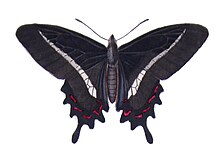Parides bunichus is a butterfly of the family Papilionidae. It is found in Brazil, Paraguay, Argentina and Uruguay.
| Parides bunichus | |
|---|---|

| |
| P. b. damocrates, male | |

| |
| P. b. chamissonia | |
| Scientific classification | |
| Domain: | Eukaryota |
| Kingdom: | Animalia |
| Phylum: | Arthropoda |
| Class: | Insecta |
| Order: | Lepidoptera |
| Family: | Papilionidae |
| Genus: | Parides |
| Species: | P. bunichus
|
| Binomial name | |
| Parides bunichus | |
| Synonyms | |
| |
The larva is brownish black, with an oblique white band, extending laterally from the 6th segment to the tubercle on the 7th. The pupal stage lasts three weeks.
The butterfly is very common and is one of the earliest spring species (August). From August to April there are at least three generations.

Subspecies edit
- P. b. bunichus (Brazil: Santa Catarina, São Paulo, Rio de Janeiro, Paraná, Santa Catarina)
- P. b. chamissonia (Eschscholtz, 1821) (Brazil: Santa Catarina) Both wings with white band, that on the hindwing abbreviated; cell-spot of the hindwing not extending further towards the base than to the second median; red anal spot v-shaped. In forma echedorus Boisduval the fringes are partly black, at least at the extremities of the veins.
- P. b. damocrates (Guenée, 1872) (Argentina, Uruguay) Much paler; the head and palpi are black, and the submarginal spots on the upper surface of the hindwing are not bright red.
- P. b. diodorus (Hopffer, 1863) (Brazil: Goias, Bahia, Minas Gerais) Has entirely white fringes. The breadth of the white band is variable.
- P. b. perrhebus (Boisduval, 1836) (Paraguay, Brazil (São Paulo, Paraná, Santa Catarina, Rio Grande do Sul), northern Argentina) [2]
Status edit
Parides bunichus is common and not threatened.[3]
Taxonomy edit
Parides bunichus is a member of the ascanius species group[4] ("Fringe-spots white. Hindwing with submarginal spots and usnally also discal spots or dots, or a discal band ; mostly with tail") A quadrate whitish spot in space 2 of the forewings is quite peculiar of the ascanius group[5]
The members are
- Parides agavus (Drury, 1782)
- Parides alopius (Godman & Salvin, [1890])
- Parides ascanius (Cramer, [1775])
- Parides bunichus (Hübner, [1821])
- Parides gundlachianus (C. & R. Felder, 1864)
- Parides montezuma (Westwood, 1842)
- Parides phalaecus (Hewitson, 1869)
- Parides photinus (Doubleday, 1844)
- Parides proneus (Hübner, [1831])
References edit
- ^ "Parides at funet". Nic.funet.fi. 2012-04-28. Retrieved 2012-06-11.
- ^ Jordan, K. , in Seitz, A. ( 1907) . The Macrolepidoptera of the World. 5: The Macrolepidoptera of the American faunistic region. Papilionidae 1-45. This article incorporates text from this source, which is in the public domain.
- ^ Collins, N. Mark; Morris, Michael G. (1985). Threatened Swallowtail Butterflies of the World: The IUCN Red Data Book. Gland & Cambridge: IUCN. ISBN 978-2-88032-603-6 – via Biodiversity Heritage Library.
- ^ Rothschild, W. and Jordan, K. (1906). A revision of the American Papilios. Novitates Zoologicae 13: 411-752. online (and as pdf) (Facsimile edition ed. P.H. Arnaud, 1967).
- ^ Racheli, Tommaso an Olmisani. Luca 1998. A cladistic analysis of the genus Parides Hubner, [1819], based on androconial structures (Lepidoptera: Papilionidae). Neue Ent. Nachr. (Marktleuthen),41:119-131.pdf